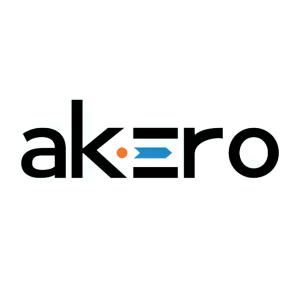Akero Therapeutics to Showcase New Analyses of Phase 2b HARMONY Study in Presentations at 75th Annual AASLD The Liver Meeting® 2024
Rhea-AI Summary
Akero Therapeutics presented new analyses of its Phase 2b HARMONY study for efruxifermin (EFX) in treating metabolic dysfunction-associated steatohepatitis (MASH). Over 40% of participants treated with EFX 50mg for 96 weeks showed regression of liver fibrosis across three measures, compared to 0% for placebo. 30% of participants receiving EFX 50mg achieved almost complete MASH disease reversal. The study demonstrated consistent improvements in liver health markers, with AI-based digital pathology confirming conventional histopathology assessments. The 50mg dose showed superior results compared to the 28mg dose, with significant reductions in fibrosis in both perisinusoidal and periportal zones of the liver.
Positive
- 40% of patients on EFX 50mg showed liver fibrosis regression vs 0% for placebo
- 30% of patients on EFX 50mg achieved near-complete MASH disease reversal
- 100% of EFX 50mg patients reached 'low risk' status for progressive MASH
- Significant improvements confirmed by both conventional and AI-based pathology
Negative
- Lower efficacy observed with 28mg dose compared to 50mg dose
- Results to pre-cirrhotic MASH patients (F2-F3 stages only)
Insights
The 96-week Phase 2b HARMONY study results demonstrate remarkable efficacy of efruxifermin (EFX) in treating MASH. The 50mg dose showed exceptional outcomes, with
The multi-modal validation approach, combining conventional histopathology, AI-based digital pathology and non-invasive biomarkers, provides robust evidence of EFX's anti-fibrotic effects. The consistent improvement in perisinusoidal and periportal zones suggests comprehensive liver healing. The dose-dependent response, with 50mg showing superior outcomes to 28mg, establishes a clear therapeutic window for the ongoing Phase 3 SYNCHRONY program.
-- Over
-- Analysis of biopsies by AI-based Digital Pathology (qFibrosis®, Histoindex) corroborated the extent of improvement in fibrosis observed with conventional histopathology after 24 and 96 weeks of EFX treatment, including statistically significant reductions in fibrosis within the perisinusoidal and periportal zones of the liver –
--
SOUTH SAN FRANCISCO, Calif., Nov. 15, 2024 (GLOBE NEWSWIRE) -- Akero Therapeutics, Inc. (Nasdaq: AKRO), a clinical-stage company developing transformational treatments for patients with serious metabolic diseases marked by high unmet medical need, today announced results of analyses supporting the clinical activity of efruxifermin (EFX) in metabolic dysfunction-associated steatohepatitis (MASH) in one oral presentation and two late-breaking poster presentations at the 75th Annual American Association for the Study of Liver Diseases (AASLD) The Liver Meeting®, held November 15-19, 2024, in San Diego.
“The data to be presented at The Liver Meeting® show that 96 weeks of treatment with EFX has the potential to drive substantial reversal of disease in patients living with pre-cirrhotic MASH,” said Kitty Yale, chief development officer of Akero. “We are encouraged by consistent improvements observed across a number of clinically established markers of liver health and the corroboration of conventional histopathology assessments with Artificial Intelligence (AI)-based digital pathology. We believe these new analyses provide further evidence for the potential of EFX to be a differentiated therapy for MASH.”
An oral presentation will highlight findings from the completed 96-week Phase 2b HARMONY study in patients with pre-cirrhotic MASH, fibrosis stages F2-F3. These findings include assessment of liver biopsies by conventional histopathology and AI-based digital pathology, as well as analyses of individual participants’ responses across clinically established measures of liver fibrosis:
- AI-based digital pathology scoring of fibrosis (by HistoIndex, using their proprietary qFibrosis scoring) corroborated the EFX-associated histopathologic improvements scored by per-protocol consensus reads, and highlighted statistically significant EFX-associated reductions in qFibrosis® in both the perisinusoidal and periportal zones of the liver after 24 and 96 weeks of treatment.
- In addition, analysis of changes in multi-modal, non-invasive markers of liver fibrosis among individual participants showed that:
- More than half of individuals treated with EFX 50mg experienced clinically meaningful reductions in both widely used non-invasive tests of fibrosis (liver stiffness by FibroScan® vibration-controlled transient elastrography [VCTE] and Enhanced Liver Fibrosis [ELFTM] Test), approximately nine-fold the rate of placebo.
- Over
40% of individuals treated with EFX 50mg for 96 weeks experienced improved fibrosis by conventional histopathology, as well as clinically meaningful improvements in imaging (liver stiffness by FibroScan®) and serum (ELFTM score) biomarkers of liver fibrosis, compared with0% of individuals on placebo. - The proportion of individuals who responded to EFX 28 mg was smaller than that for EFX 50mg based on these same measures:
Proportions of Participants with Improved Liver Fibrosis as Indicated by Congruence of Improvements in Non-Invasive Markers of Fibrosis
and Conventional Histopathology After EFX Treatment
| Responder Type (Proportion of Participants)1 | Placebo (N=32) | EFX 28mg (N=26) | EFX 50mg (N=24) | |||
| ELFTM (≥0.5 absolute reduction in score) | 25 | % | 58 | % | 71 | % |
| Liver Stiffness (≥ | 19 | % | 50 | % | 71 | % |
| ELFTM + Liver Stiffness | 6 | % | 38 | % | 54 | % |
| ELFTM + Liver Stiffness + Histopathology2 | 0 | % | 19 | % | 42 | % |
1 Based on those patients with baseline and Week 96 measurements of ELFTM score, liver stiffness (FibroScan®), and conventional histopathology
2 Fibrosis improvement ≥1 stage without MASH worsening, by conventional histopathology
One poster (#5047) presents an orthogonal analysis of baseline, week 24, and week 96 liver biopsies from HARMONY by HistoIndex. This analysis corroborates the pattern of anti-fibrotic effects observed with conventional pathology after treatment with EFX for 24 or 96 weeks. Specifically, a quantitative analysis by qFibrosis® across different zones of the liver revealed EFX-associated reductions in fibrosis primarily in the perisinusoidal and periportal zones that were sustained or expanded from weeks 24 through 96 for participants, regardless of baseline fibrosis stage.
The second poster (#5021) presentation shows that
“We believe that, taken together, the suite of presentations provides evidence supporting the consistent anti-fibrotic effects of EFX observed to date in the HARMONY trial as well as the the clinical activity and generally favorable safety profile of EFX in patients with precirrhotic MASH (F2-F3). The ongoing Phase 3 SYNCHRONY program is designed to confirm a favorable benefit-risk profile and support marketing applications for EFX for the treatment of MASH,” said Ms. Yale.
Details for the presentations are as follows:
Title: Efruxifermin Significantly Improved Liver Fibrosis at Week 96 in the HARMONY Study Across Subgroups and Improvements Were Associated With Changes in Biomarkers
Speaker: Mazen Noureddin, M.D., M.H.Sc., Professor of Medicine, Houston Methodist Hospital and Director, Houston Research Institute
Date/Time: Sunday, November 17, 2024, from 2:00 PM – 2:15 PM PST
Publication Number: 158
Oral Session: MASLD and MASH – New Therapies
Title: AI and digital-based pathology corroborate reduction in fibrosis observed by conventional pathology with efruxifermin treatment of patients with F2-F3 MASH in the HARMONY study
Presenter: Mazen Noureddin, M.D., M.H.Sc., Professor of Medicine, Houston Methodist Hospital and Director, Houston Research Institute
Date/Time: Monday, November 18, 2024, from 8:00 AM – 5:00 PM PST
Publication Number: 5047
Session: Late Breaking Posters
Title: Efruxifermin significantly reduced proportion of subjects with at-risk MASH and led to near-complete histological disease reversal at week 96 in the HARMONY study
Presenter: Mazen Noureddin, M.D., M.H.Sc., Professor of Medicine, Houston Methodist Hospital and Director, Houston Research Institute
Date/Time: Monday, November 18, 2024, from 8:00 AM – 5:00 PM PST
Publication Number: 5021
Session: Late Breaking Posters
About Akero Therapeutics
Akero Therapeutics is a clinical-stage company developing transformational treatments for patients with serious metabolic diseases marked by high unmet medical need, including MASH. Akero’s lead product candidate, EFX, is currently being evaluated in three ongoing Phase 3 clinical trials in patients with pre-cirrhotic MASH (F2-F3) or compensated cirrhosis (F4) due to MASH: SYNCHRONY Histology, SYNCHRONY Real-World, and SYNCHRONY Outcomes. The SYNCHRONY program builds on the results of two Phase 2b clinical trials, the completed HARMONY study in patients with pre-cirrhotic MASH (F2-F3) and the ongoing SYMMETRY study in patients with compensated cirrhosis (F4) due to MASH, in which more than 300 patients have been treated with EFX or placebo for up to 96 weeks. Akero is headquartered in South San Francisco. Visit us at akerotx.com and follow us on LinkedIn and X for more information.
Forward Looking Statements
Statements contained in this press release regarding matters that are not historical facts are “forward-looking statements” within the meaning of the Private Securities Litigation Reform Act of 1995. Because such statements are subject to risks and uncertainties, actual results may differ materially from those expressed or implied by such forward-looking statements, including, but not limited to, statements regarding Akero’s business plans and objectives, including future plans orexpectations for EFX and its potential differentiated profile; the therapeutic effects of EFX; as well as the dosing, clinical activity,safety and tolerability of EFX. Any forward-looking statements in this press release are based on management’s current expectations of future events and are subject to a number of risks and uncertainties that could cause actual results to differ materially and adversely from those set forth in or implied by such forward-looking statements. Risks that contribute to the uncertain nature of the forward-looking statements include: the success, cost, and timing of Akero’s product candidate development activities and planned clinical trials; Akero’s ability to execute on its strategy; positive results from a clinical study may not necessarily be predictive of the results of future or ongoing clinical studies; regulatory developments in the United States and foreign countries; Akero’s ability to fund operations; as well as those risks and uncertainties set forth more fully under the caption “Risk Factors” in Akero’s most recent Annual Report on Form 10-K and Quarterly Report on Form 10-Q, as filed with the Securities and Exchange Commission (SEC) as well as discussions of potential risks, uncertainties and other important factors in Akero’s other filings and reports with the SEC. All forward-looking statements contained in this press release speak only as of the date on which they were made. Akero undertakes no obligation to update such statements to reflect events that occur or circumstances that exist after the date on which they were made.
Investor Contact:
Christina Tartaglia
Precision AQ
212.362.1200
christina.tartaglia@precisionaq.com
Media Contact:
Peg Rusconi
Deerfield Group
Peg.rusconi@deerfieldgroup.com








